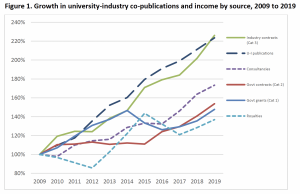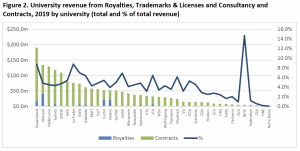October 20, 2021
Higher Education Research Commercialisation IP Framework – IRU Response
The Innovative Research Universities (IRU) support the Australian Government’s intention to incentivise and increase partnerships between businesses and universities through research commercialisation. By better facilitating commercialisation and translation, we can further strengthen our national capacity to invest in research and realise its benefits, creating a positive loop in Australia’s world leading R&D sectors. A framework of standardised agreements, templates, guidance and terminology for the treatment of intellectual property (IP) in commercialisation has the potential to overcome some of the constraints that inhibit the transfer of publicly funded research into commercial outcomes benefiting universities, business and society.
Despite supporting the positive intentions of the proposed IP Framework, the IRU is concerned that the key details of the Framework’s scope and parameters are underdeveloped. Some of the underlying principles and assumptions may be misguided upon further consultation. Mandatory standardisation is expected to increase commercialisation revenue, but this approach departs from the successful practices in the UK and Ireland that the IP Framework is seeking to emulate. No evidence or rationale is provided from universities or industry that standardisation is desirable.
Direct commercial outcomes are also only one part of a broad suite of ways in which research is used for economic and social benefit. In the announcement of the University Research Commercialisation consultation paper, Minister Tudge was clear that research commercialisation is the initial focus, but the Government concurrently wants “to continue our thinking on how universities can make a greater impact on our largest social challenges which don’t necessarily have a commercial outcome.” It is important that the IP Framework does not undermine industry and community engagement that provide “pathways to market” or social impact, including through contract research, consultancy and engagement in research training. Commercialisation is the final stage of the “innovation pipeline” and depends on early-stage research and translation.
Overall, it is difficult to assess the proposed IP Framework for its efficacy or consequences. Too many key details are unclear, presumably to be developed after this round of consultation. Instead of committing to implementing the IP Framework in advance of determining its detail, the IRU proposes that the Government continues to work with the higher education and industry sectors to develop a voluntary Framework that is fit for purpose, prior to piloting and committing to its implementation.
Recommendations
The IRU submission supports Universities Australia’s position on the IP Framework, including the following key recommendations that the Government:
1. Delay introduction of the IP Framework;
2. Establish a steering committee and undertake a fuller stakeholder consultation;
3. Pilot, test and refine the IP Framework, then consider full implementation with voluntary uptake.
The remainder of the IRU submission further outlines initiatives for the Government to consider.
Supporting research commercialisation through an IP Framework
1. A voluntary IP Framework with devolved decision making
The IP Framework needs to be flexible and support a breadth of activities and partnerships. The aim is to make research-driven innovation part of business as usual across most enterprises by overcoming IP barriers that may arise when partnering with universities. This is best achieved through devolved decision making. Devolved decision making around IP ensures that the partners with greatest knowledge about the research process have autonomy to make decisions. The IP Framework consultation paper acknowledges that these negotiations may initially be difficult: “Businesses think universities overvalue their technology, research and IP, and universities think businesses undervalue the technology and the university’s pre-existing IP”. However, a mandatory and rigid IP Framework is not likely to solve this problem. It may lead to greater standardisation across agreements, but at the cost of fewer agreements and collaborations. IRU members have indicated that this is also a concern of their industry partners. Therefore, it is important that the IP Framework is voluntary and guide decision marking, rather than dictate it.
2. Support commercialisation across the innovation pipeline, including PhD training
Commercialisation of research can produce great social and economic benefits, but as the Government’s University Research Commercialisation consultation paper recognised, commercialisation is the final stage of a complex “innovation pipeline”. Commercialisation cannot occur without high quality early-stage research and translation activities. Quality research and translation will not always lead to commercial returns, but collaboration with industry at each stage increases the frequency and likelihood of commercial success. Given the range of Australian Government initiatives supporting industry collaboration on PhD training, it is essential that the IP Framework does not prevent growth in this area, or any PhD candidate from having their thesis assessed or examined as a consequence of these arrangements.
3. Establish a governance structure to guide the IP Framework
The IP Framework lacks a clear and formal governance structure to guide stakeholder consultation, piloting, refinement and implementation. The Defence Trade Control Act’s Implementation Steering Group offers a suitable model that the IP Framework could replicate. Representation could be extended to other parts of the innovation system that are specifically designed to support university-industry collaboration, such as CRCs and RRDCs. Universities and industry are already significantly invested in those bodies, yet there is limited evidence that their expertise has been utilised in the development of the IP Framework.
4. Commercialisation, contracts and collaboration are different (but all are growing)
The IP Framework consultation paper’s concerns about “unsatisfactory performance in commercialisation and collaboration” conflates distinctly different issues. As outlined in the IRU’s submission to the University Research Commercialisation consultation paper, Australia’s performance on university-industry collaboration has improved steadily over the past decade. As shown in Figure 1 below, university-industry co-authored publications in the Scopus database have more than doubled over the past decade (224% compared to 2009 levels). For IRU members, the total number of university-industry co-authored publications has more than quadruped (406% compared to 2009 levels). Industry funded research has increased at an even greater rate (Category 3 research income, 226% compared to 2009). Consultancy and contracts have also comfortably grown at a greater rate than public funding sources. Growth in royalties, trademarks and licencing revenue has not kept pace with government grants or government funded research and rightly should be the focus of attention, but the reasons for its lower growth rate may have little to do with efforts on collaboration.
5. Ensure that the commercialisation IP Framework does not hinder other collaboration and pathways
In 2019, Australian universities generated $136 million in revenue directly from direct commercialisation through royalties, trademarks and licenses. This comprised 0.4% of total revenue for the sector. Successful commercialisation is lucrative but rare, which means most universities generate far less than 0.4%. Only four universities in 2019 generated more than 1% of their revenue from direct commercialisation. Although it is possible that standardised approaches towards IP agreements will increase commercialisation, there are risks that an IP Framework intended to target royalties, trademarks and licenses may undermine indirect commercialisation and collaboration with industry and community organisations on pathway activities.
Many universities have productive relationships with government, hospitals, schools and communities, driving strong outcomes and economic benefit. Taking a broader definition of commercialisation to include advice and consultancy to private enterprise, government, not for profit organisations, and other third parties, universities generated $1.6 billion in revenue in 2019, 4.3% of total revenue. Consultancy and contracts include non-research services, but university staff utilise their research expertise in their services to business and the community.
Retaining more of the financial benefits within the higher education sector is the main focus of the IP Framework discussion paper. However, the commercialisation of university R&D can also create economic benefits purely for the industry partner. Universities may not be acknowledged or directly benefit from this, yet it does support the broader R&D intensity of industry, their productivity, profitability (and taxation revenue to government), and capacity to employ university graduates in knowledge-intensive roles.
The total value of university consultancy and contract research also underestimates the full suite of benefits from this growing external engagement. As publicly spirited institutions, universities and academics engage in knowledge transfer activities and support local communities and industries even when short-term financial returns are uncertain or minor. This also helps ensure the university education mission aligns with community needs and expectations, such as through industry-informed curriculum development and work-integrated learning activities that build upon existing research partnerships. Such partnerships may or may not have commercialisation potential, but could get held up by constraints within the IP Framework.
Whereas direct commercialisation is skewed towards a small number of larger metropolitan universities, indirect commercialisation through contract and consultancy is widespread across the sector. Most universities generate between 4% to 6% of their revenue from these activities. For IRU as a whole, 5.2% of revenue is generated from indirect commercialisation compared to 0.2% from royalties, trademarks and licences. Therefore, it is important that the whole of the higher education system has opportunities to engage fully with the IP Framework development and its effects on pathway activities. In 2019, the institutions that generated the greatest share of revenue from consultancies were the Batchelor Institute (15% of total revenue) and La Trobe University (9%), both of which have deep engagement with their local communities, including Indigenous communities. The complexity of how to consider Indigenous Knowledge in the IP Framework is particularly relevant and should be considered further prior to implementation.









